Training and Development: Methods, Practices, and Contributions Report
VerifiedAdded on 2020/05/16
|6
|1567
|130
Report
AI Summary
This report delves into the critical aspects of training and development within organizations, particularly focusing on the context of the United Arab Emirates (UAE). It examines the methods used to develop Training Needs Analysis (TNA) tools, emphasizing the importance of identifying individual training needs and utilizing tools like OJT, mentoring, and coaching. The report highlights best practices in developing TNA tools, such as direct communication with employees, and addresses potential obstacles. Furthermore, it explores the contribution of training and development to overall organizational success, illustrating how training enhances employee skills, knowledge, and attitudes, ultimately leading to improved performance and goal attainment. The report references various theories, including the connectionist and cognitive learning theories, to explain the effectiveness of different training approaches and concludes with a recommendation for the effective use of TNA for organizational improvement. The report draws insights from different organizations in the UAE such as Abu Dhabi Commercial Bank, Fujairah municipality, Abu Dhabi Media, Air Arabia and Emirates trading agency.
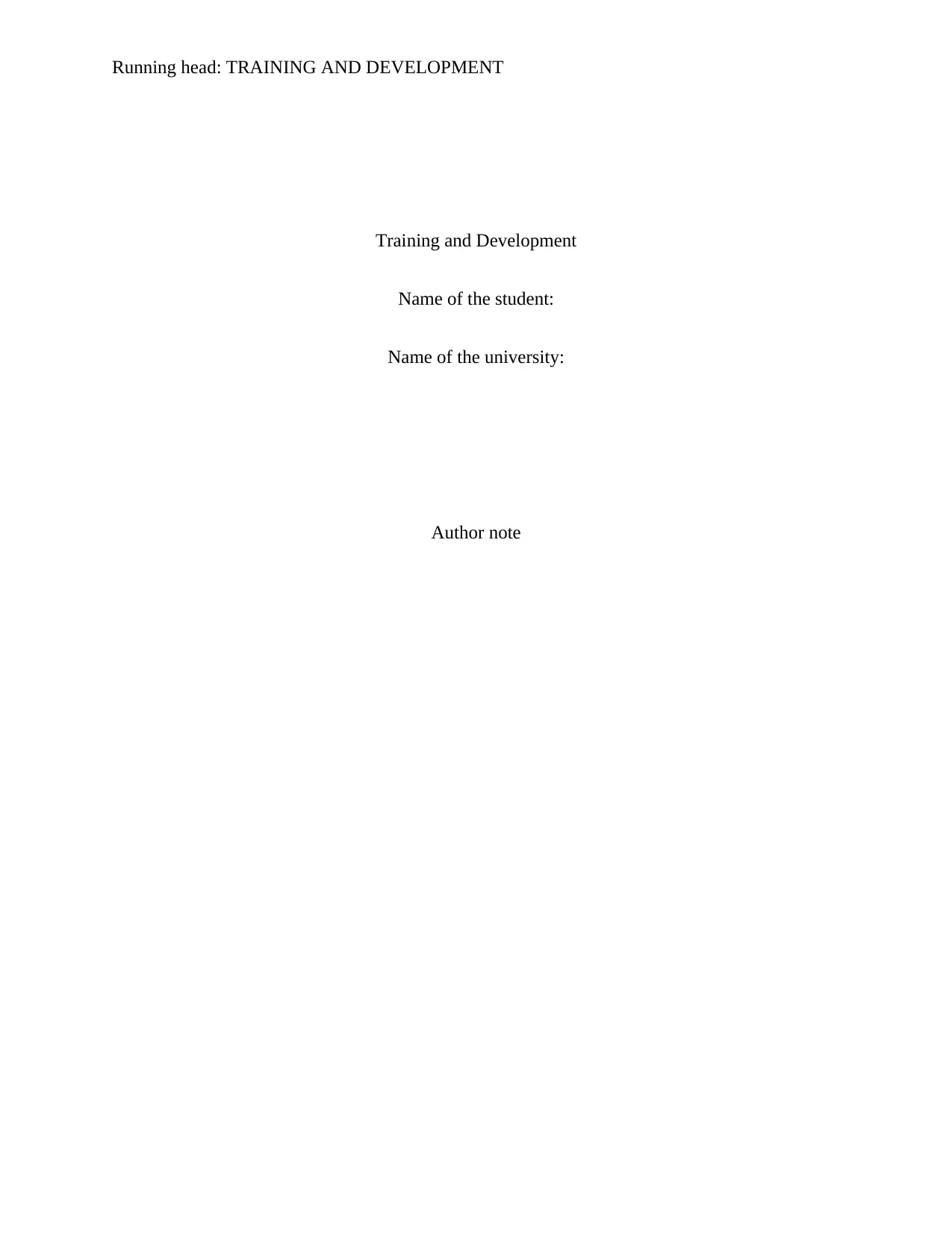
Running head: TRAINING AND DEVELOPMENT
Training and Development
Name of the student:
Name of the university:
Author note
Training and Development
Name of the student:
Name of the university:
Author note
Paraphrase This Document
Need a fresh take? Get an instant paraphrase of this document with our AI Paraphraser
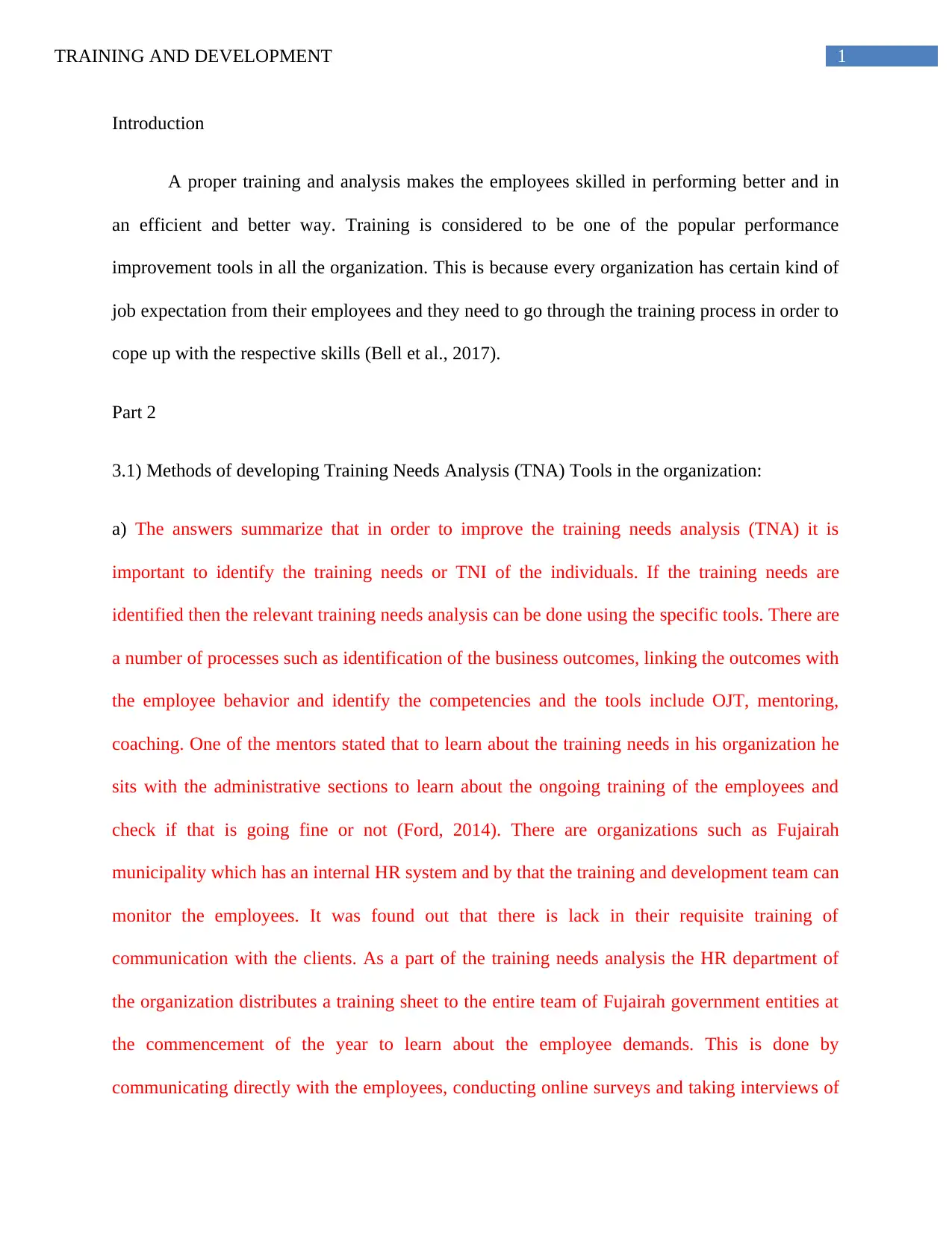
1TRAINING AND DEVELOPMENT
Introduction
A proper training and analysis makes the employees skilled in performing better and in
an efficient and better way. Training is considered to be one of the popular performance
improvement tools in all the organization. This is because every organization has certain kind of
job expectation from their employees and they need to go through the training process in order to
cope up with the respective skills (Bell et al., 2017).
Part 2
3.1) Methods of developing Training Needs Analysis (TNA) Tools in the organization:
a) The answers summarize that in order to improve the training needs analysis (TNA) it is
important to identify the training needs or TNI of the individuals. If the training needs are
identified then the relevant training needs analysis can be done using the specific tools. There are
a number of processes such as identification of the business outcomes, linking the outcomes with
the employee behavior and identify the competencies and the tools include OJT, mentoring,
coaching. One of the mentors stated that to learn about the training needs in his organization he
sits with the administrative sections to learn about the ongoing training of the employees and
check if that is going fine or not (Ford, 2014). There are organizations such as Fujairah
municipality which has an internal HR system and by that the training and development team can
monitor the employees. It was found out that there is lack in their requisite training of
communication with the clients. As a part of the training needs analysis the HR department of
the organization distributes a training sheet to the entire team of Fujairah government entities at
the commencement of the year to learn about the employee demands. This is done by
communicating directly with the employees, conducting online surveys and taking interviews of
Introduction
A proper training and analysis makes the employees skilled in performing better and in
an efficient and better way. Training is considered to be one of the popular performance
improvement tools in all the organization. This is because every organization has certain kind of
job expectation from their employees and they need to go through the training process in order to
cope up with the respective skills (Bell et al., 2017).
Part 2
3.1) Methods of developing Training Needs Analysis (TNA) Tools in the organization:
a) The answers summarize that in order to improve the training needs analysis (TNA) it is
important to identify the training needs or TNI of the individuals. If the training needs are
identified then the relevant training needs analysis can be done using the specific tools. There are
a number of processes such as identification of the business outcomes, linking the outcomes with
the employee behavior and identify the competencies and the tools include OJT, mentoring,
coaching. One of the mentors stated that to learn about the training needs in his organization he
sits with the administrative sections to learn about the ongoing training of the employees and
check if that is going fine or not (Ford, 2014). There are organizations such as Fujairah
municipality which has an internal HR system and by that the training and development team can
monitor the employees. It was found out that there is lack in their requisite training of
communication with the clients. As a part of the training needs analysis the HR department of
the organization distributes a training sheet to the entire team of Fujairah government entities at
the commencement of the year to learn about the employee demands. This is done by
communicating directly with the employees, conducting online surveys and taking interviews of
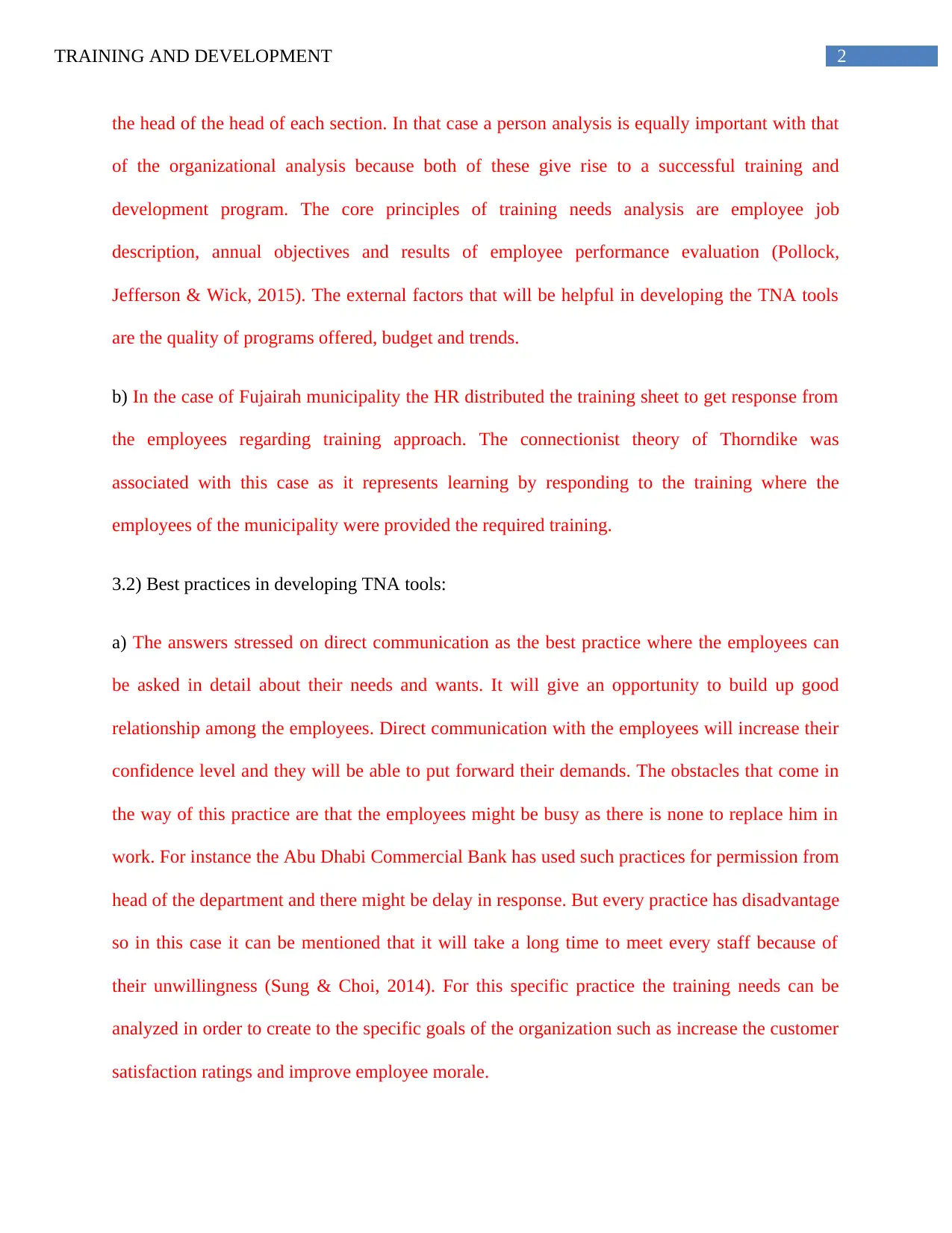
2TRAINING AND DEVELOPMENT
the head of the head of each section. In that case a person analysis is equally important with that
of the organizational analysis because both of these give rise to a successful training and
development program. The core principles of training needs analysis are employee job
description, annual objectives and results of employee performance evaluation (Pollock,
Jefferson & Wick, 2015). The external factors that will be helpful in developing the TNA tools
are the quality of programs offered, budget and trends.
b) In the case of Fujairah municipality the HR distributed the training sheet to get response from
the employees regarding training approach. The connectionist theory of Thorndike was
associated with this case as it represents learning by responding to the training where the
employees of the municipality were provided the required training.
3.2) Best practices in developing TNA tools:
a) The answers stressed on direct communication as the best practice where the employees can
be asked in detail about their needs and wants. It will give an opportunity to build up good
relationship among the employees. Direct communication with the employees will increase their
confidence level and they will be able to put forward their demands. The obstacles that come in
the way of this practice are that the employees might be busy as there is none to replace him in
work. For instance the Abu Dhabi Commercial Bank has used such practices for permission from
head of the department and there might be delay in response. But every practice has disadvantage
so in this case it can be mentioned that it will take a long time to meet every staff because of
their unwillingness (Sung & Choi, 2014). For this specific practice the training needs can be
analyzed in order to create to the specific goals of the organization such as increase the customer
satisfaction ratings and improve employee morale.
the head of the head of each section. In that case a person analysis is equally important with that
of the organizational analysis because both of these give rise to a successful training and
development program. The core principles of training needs analysis are employee job
description, annual objectives and results of employee performance evaluation (Pollock,
Jefferson & Wick, 2015). The external factors that will be helpful in developing the TNA tools
are the quality of programs offered, budget and trends.
b) In the case of Fujairah municipality the HR distributed the training sheet to get response from
the employees regarding training approach. The connectionist theory of Thorndike was
associated with this case as it represents learning by responding to the training where the
employees of the municipality were provided the required training.
3.2) Best practices in developing TNA tools:
a) The answers stressed on direct communication as the best practice where the employees can
be asked in detail about their needs and wants. It will give an opportunity to build up good
relationship among the employees. Direct communication with the employees will increase their
confidence level and they will be able to put forward their demands. The obstacles that come in
the way of this practice are that the employees might be busy as there is none to replace him in
work. For instance the Abu Dhabi Commercial Bank has used such practices for permission from
head of the department and there might be delay in response. But every practice has disadvantage
so in this case it can be mentioned that it will take a long time to meet every staff because of
their unwillingness (Sung & Choi, 2014). For this specific practice the training needs can be
analyzed in order to create to the specific goals of the organization such as increase the customer
satisfaction ratings and improve employee morale.
⊘ This is a preview!⊘
Do you want full access?
Subscribe today to unlock all pages.

Trusted by 1+ million students worldwide
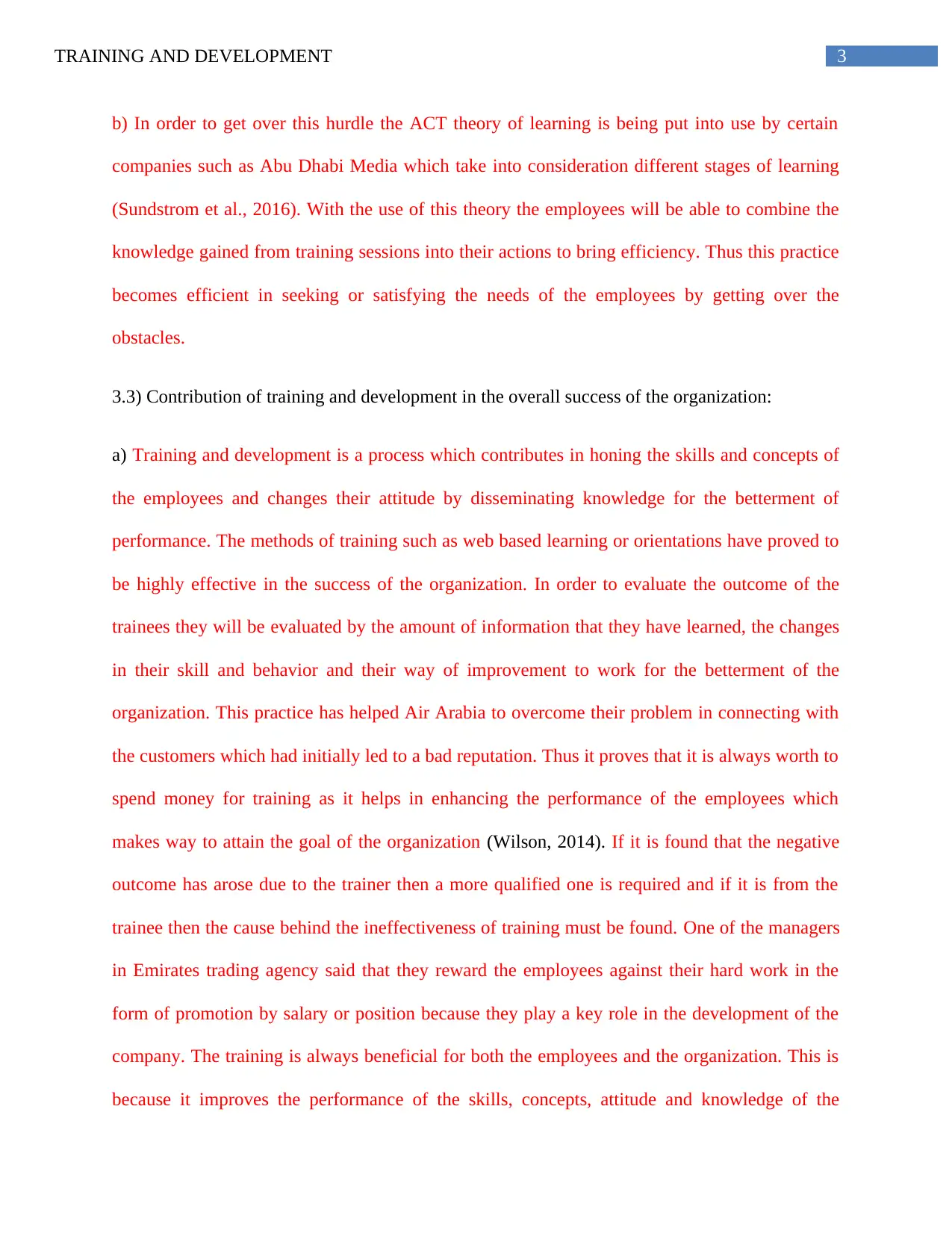
3TRAINING AND DEVELOPMENT
b) In order to get over this hurdle the ACT theory of learning is being put into use by certain
companies such as Abu Dhabi Media which take into consideration different stages of learning
(Sundstrom et al., 2016). With the use of this theory the employees will be able to combine the
knowledge gained from training sessions into their actions to bring efficiency. Thus this practice
becomes efficient in seeking or satisfying the needs of the employees by getting over the
obstacles.
3.3) Contribution of training and development in the overall success of the organization:
a) Training and development is a process which contributes in honing the skills and concepts of
the employees and changes their attitude by disseminating knowledge for the betterment of
performance. The methods of training such as web based learning or orientations have proved to
be highly effective in the success of the organization. In order to evaluate the outcome of the
trainees they will be evaluated by the amount of information that they have learned, the changes
in their skill and behavior and their way of improvement to work for the betterment of the
organization. This practice has helped Air Arabia to overcome their problem in connecting with
the customers which had initially led to a bad reputation. Thus it proves that it is always worth to
spend money for training as it helps in enhancing the performance of the employees which
makes way to attain the goal of the organization (Wilson, 2014). If it is found that the negative
outcome has arose due to the trainer then a more qualified one is required and if it is from the
trainee then the cause behind the ineffectiveness of training must be found. One of the managers
in Emirates trading agency said that they reward the employees against their hard work in the
form of promotion by salary or position because they play a key role in the development of the
company. The training is always beneficial for both the employees and the organization. This is
because it improves the performance of the skills, concepts, attitude and knowledge of the
b) In order to get over this hurdle the ACT theory of learning is being put into use by certain
companies such as Abu Dhabi Media which take into consideration different stages of learning
(Sundstrom et al., 2016). With the use of this theory the employees will be able to combine the
knowledge gained from training sessions into their actions to bring efficiency. Thus this practice
becomes efficient in seeking or satisfying the needs of the employees by getting over the
obstacles.
3.3) Contribution of training and development in the overall success of the organization:
a) Training and development is a process which contributes in honing the skills and concepts of
the employees and changes their attitude by disseminating knowledge for the betterment of
performance. The methods of training such as web based learning or orientations have proved to
be highly effective in the success of the organization. In order to evaluate the outcome of the
trainees they will be evaluated by the amount of information that they have learned, the changes
in their skill and behavior and their way of improvement to work for the betterment of the
organization. This practice has helped Air Arabia to overcome their problem in connecting with
the customers which had initially led to a bad reputation. Thus it proves that it is always worth to
spend money for training as it helps in enhancing the performance of the employees which
makes way to attain the goal of the organization (Wilson, 2014). If it is found that the negative
outcome has arose due to the trainer then a more qualified one is required and if it is from the
trainee then the cause behind the ineffectiveness of training must be found. One of the managers
in Emirates trading agency said that they reward the employees against their hard work in the
form of promotion by salary or position because they play a key role in the development of the
company. The training is always beneficial for both the employees and the organization. This is
because it improves the performance of the skills, concepts, attitude and knowledge of the
Paraphrase This Document
Need a fresh take? Get an instant paraphrase of this document with our AI Paraphraser
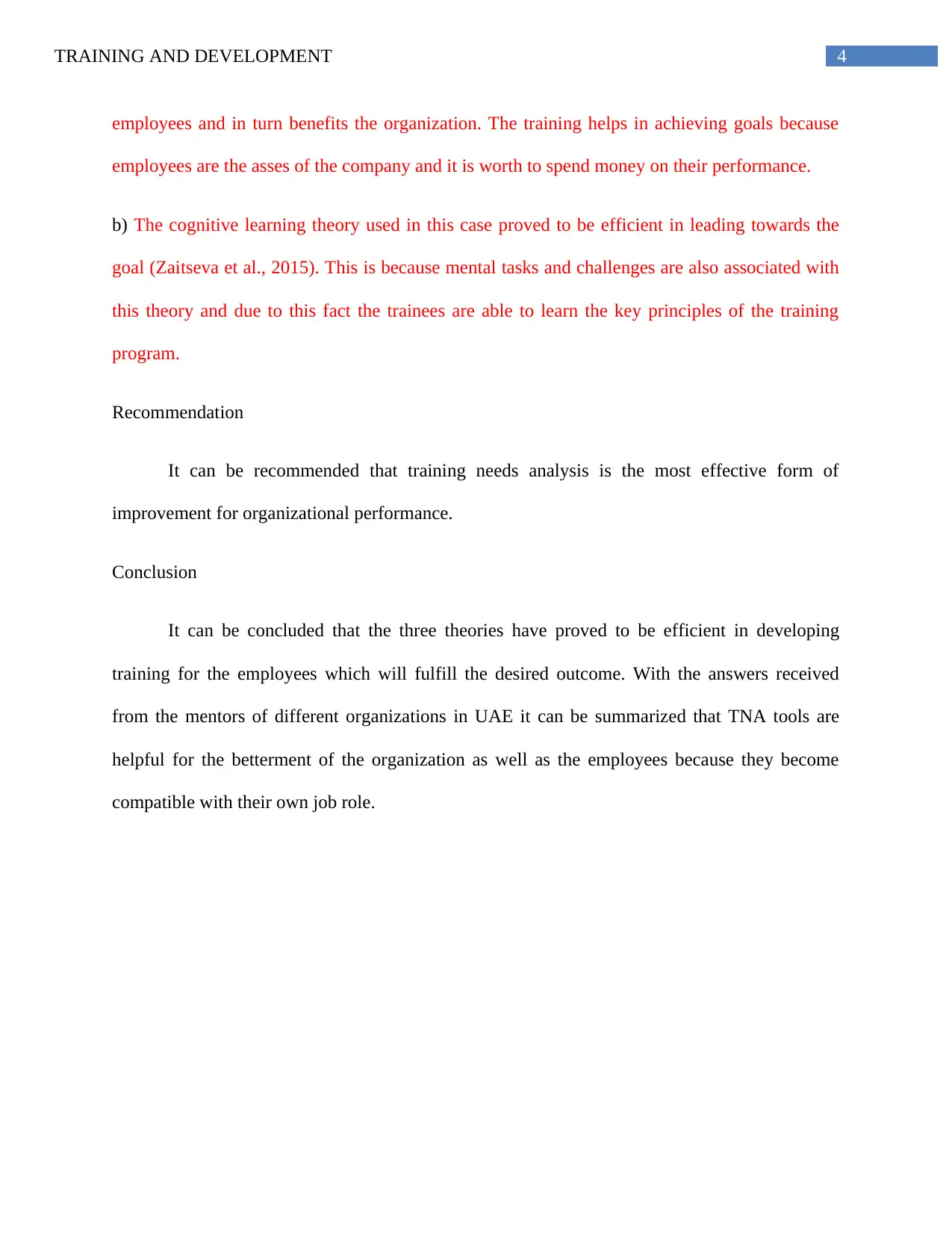
4TRAINING AND DEVELOPMENT
employees and in turn benefits the organization. The training helps in achieving goals because
employees are the asses of the company and it is worth to spend money on their performance.
b) The cognitive learning theory used in this case proved to be efficient in leading towards the
goal (Zaitseva et al., 2015). This is because mental tasks and challenges are also associated with
this theory and due to this fact the trainees are able to learn the key principles of the training
program.
Recommendation
It can be recommended that training needs analysis is the most effective form of
improvement for organizational performance.
Conclusion
It can be concluded that the three theories have proved to be efficient in developing
training for the employees which will fulfill the desired outcome. With the answers received
from the mentors of different organizations in UAE it can be summarized that TNA tools are
helpful for the betterment of the organization as well as the employees because they become
compatible with their own job role.
employees and in turn benefits the organization. The training helps in achieving goals because
employees are the asses of the company and it is worth to spend money on their performance.
b) The cognitive learning theory used in this case proved to be efficient in leading towards the
goal (Zaitseva et al., 2015). This is because mental tasks and challenges are also associated with
this theory and due to this fact the trainees are able to learn the key principles of the training
program.
Recommendation
It can be recommended that training needs analysis is the most effective form of
improvement for organizational performance.
Conclusion
It can be concluded that the three theories have proved to be efficient in developing
training for the employees which will fulfill the desired outcome. With the answers received
from the mentors of different organizations in UAE it can be summarized that TNA tools are
helpful for the betterment of the organization as well as the employees because they become
compatible with their own job role.
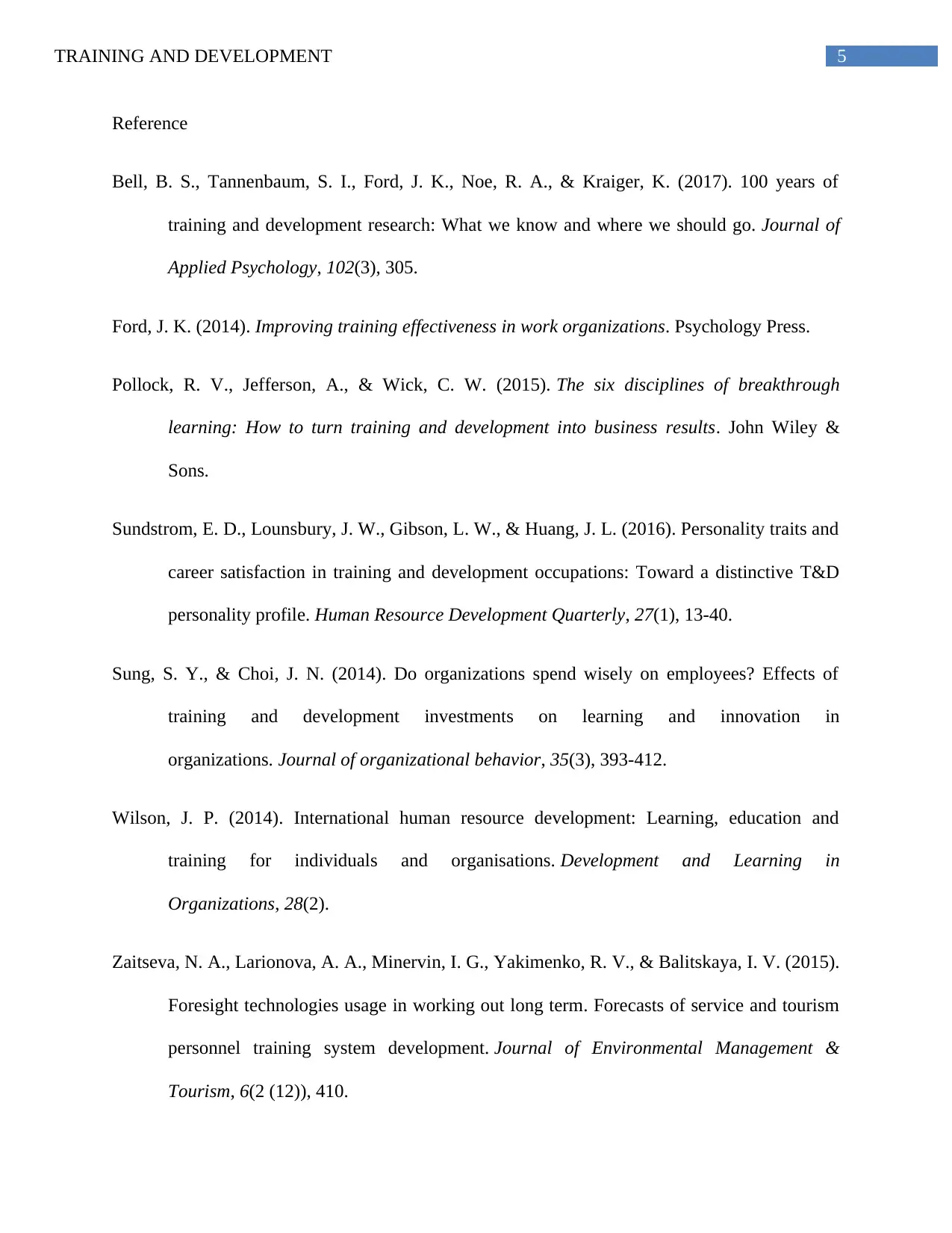
5TRAINING AND DEVELOPMENT
Reference
Bell, B. S., Tannenbaum, S. I., Ford, J. K., Noe, R. A., & Kraiger, K. (2017). 100 years of
training and development research: What we know and where we should go. Journal of
Applied Psychology, 102(3), 305.
Ford, J. K. (2014). Improving training effectiveness in work organizations. Psychology Press.
Pollock, R. V., Jefferson, A., & Wick, C. W. (2015). The six disciplines of breakthrough
learning: How to turn training and development into business results. John Wiley &
Sons.
Sundstrom, E. D., Lounsbury, J. W., Gibson, L. W., & Huang, J. L. (2016). Personality traits and
career satisfaction in training and development occupations: Toward a distinctive T&D
personality profile. Human Resource Development Quarterly, 27(1), 13-40.
Sung, S. Y., & Choi, J. N. (2014). Do organizations spend wisely on employees? Effects of
training and development investments on learning and innovation in
organizations. Journal of organizational behavior, 35(3), 393-412.
Wilson, J. P. (2014). International human resource development: Learning, education and
training for individuals and organisations. Development and Learning in
Organizations, 28(2).
Zaitseva, N. A., Larionova, A. A., Minervin, I. G., Yakimenko, R. V., & Balitskaya, I. V. (2015).
Foresight technologies usage in working out long term. Forecasts of service and tourism
personnel training system development. Journal of Environmental Management &
Tourism, 6(2 (12)), 410.
Reference
Bell, B. S., Tannenbaum, S. I., Ford, J. K., Noe, R. A., & Kraiger, K. (2017). 100 years of
training and development research: What we know and where we should go. Journal of
Applied Psychology, 102(3), 305.
Ford, J. K. (2014). Improving training effectiveness in work organizations. Psychology Press.
Pollock, R. V., Jefferson, A., & Wick, C. W. (2015). The six disciplines of breakthrough
learning: How to turn training and development into business results. John Wiley &
Sons.
Sundstrom, E. D., Lounsbury, J. W., Gibson, L. W., & Huang, J. L. (2016). Personality traits and
career satisfaction in training and development occupations: Toward a distinctive T&D
personality profile. Human Resource Development Quarterly, 27(1), 13-40.
Sung, S. Y., & Choi, J. N. (2014). Do organizations spend wisely on employees? Effects of
training and development investments on learning and innovation in
organizations. Journal of organizational behavior, 35(3), 393-412.
Wilson, J. P. (2014). International human resource development: Learning, education and
training for individuals and organisations. Development and Learning in
Organizations, 28(2).
Zaitseva, N. A., Larionova, A. A., Minervin, I. G., Yakimenko, R. V., & Balitskaya, I. V. (2015).
Foresight technologies usage in working out long term. Forecasts of service and tourism
personnel training system development. Journal of Environmental Management &
Tourism, 6(2 (12)), 410.
⊘ This is a preview!⊘
Do you want full access?
Subscribe today to unlock all pages.

Trusted by 1+ million students worldwide
1 out of 6
Related Documents
Your All-in-One AI-Powered Toolkit for Academic Success.
+13062052269
info@desklib.com
Available 24*7 on WhatsApp / Email
![[object Object]](/_next/static/media/star-bottom.7253800d.svg)
Unlock your academic potential
Copyright © 2020–2025 A2Z Services. All Rights Reserved. Developed and managed by ZUCOL.





